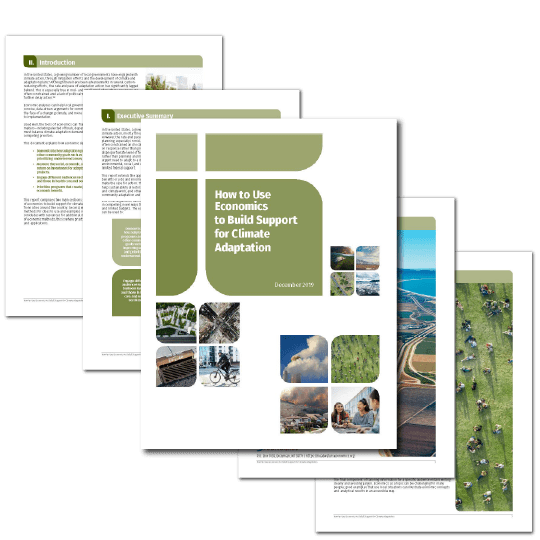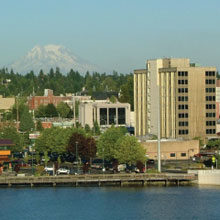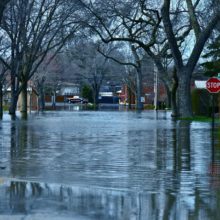
In this report, we describe how to use economics to build support for climate adaptation. Using case studies from cities large and small, we describe:
- How to effectively use economic data and methods;
- Eight types of economic analyses for climate adaptation; and
- How to clearly communicate economic data to different audiences.
A growing number of local governments are taking steps toward climate adaptation, mostly through the development of climate adaptation plans. However, the rate and pace of adaptation action has significantly lagged behind planning, especially in mid- and small-sized municipalities where resources are often limited and local politics may further delay action. The prevalence of response rather than proactive action is further exacerbated by the disproportionate level of federal disaster funding available for disaster response rather than planning and mitigation.
Local governments face an increasingly urgent need to adapt to a changing climate in ways that reflect their unique environmental, social, and economic conditions, all on a balanced budget and with limited federal support.
Headwaters Economics researched and reported strategies, methods, and case studies of cities that have used economic data and methods to advance climate adaptation programs. This report was funded by the NOAA-supported Great Lakes Integrated Sciences and Assessments partnership.
Using Economics Effectively
Economic data and methods for climate adaptation strategies can be extended beyond quantification of monetary costs and benefits or jobs and income. Economic analyses can help sustainability directors, local government staff engaged with sustainability and climate work, and other partners make concise, data-driven cases for community adaptation and resilience.
Economic arguments also can help engage new audiences and frame project needs in compelling, novel ways that recognize local governments’ competing priorities and limited budgets. Economic data and methods can be used to:

Types of Economic Analyses for Climate Adaptation
Municipalities should choose a type of economic analysis that results in information that local decision-makers need. The choice of analysis method will also depend on the information and expertise available to the city. The eight methods described in this report are not mutually exclusive and, in fact, often should be combined to evaluate programs in terms of social, ecological, and economic benefits.
We describe eight economic analyses:
Benefit-cost analysis using avoided costs
This method is often used for large infrastructure investments or regulatory investments. It describes benefits of a project in terms of costs not incurred if the project proceeds. For example, Miami-Dade County, Florida, analyzed the cost of protecting county-owned assets from sea level rise and found that the cost of protecting the most vulnerable properties would be $6.3 million but would avoid $24 million in potential damages. Not all benefits can be monetized, and this method does not necessarily address who receives benefits and who bears costs.
Benefit-cost analysis using economic impacts
This method measures the change in jobs and income caused by a policy change. It can be linked to equity goals and used to support programs that may bring new jobs or activities that support businesses. For example, in southwest Florida the regional planning commission measured the economic impacts of tourists visiting the area’s mangrove forests. It used the estimate of jobs and income brought to the area by tourists visiting the protected forests to justify the costs of conservation easements.
Benefit-cost analysis using non-market valuation
Often used to support regulations to improve human or ecological health, this method measures (in dollars) seemingly unquantifiable amenities and ecosystem services that people value even though they don’t pay for them, such as health, clean air, stormwater filtration, and recreational opportunities. For example, at a Lake Erie beach, users were willing to pay an estimated $6.2 million to restore wetlands and improve beach recreation.
Cost-effectiveness analysis
Useful for activities that have specific benchmarks (e.g., greenhouse gas emissions, water conservation, health impacts), this method compares costs of different actions required to achieve a goal. For example, researchers on the River Thames basin compared the cost of a range of water treatment options to their effectiveness at lowering phosphorous levels to identify the most cost-effective strategy. Project performance data are likely available from city staff who also may be able to conduct the analysis.
Multi-criteria analysis
This method combines qualitative and quantitative metrics to compare potential projects. Flexible evaluation criteria can reflect stakeholders’ priorities; on the other hand, scoring criteria are vulnerable to manipulation so the process must be transparent. For example, New York City developed a climate risk matrix that combined assessments of climate risk to city infrastructure with planned maintenance and upgrade projects. They weighed adaptation strategies according to cost, feasibility, timing, efficacy, resiliency, and any additional benefits it provided.
Equity and distribution analysis
This method evaluates how programs will affect underserved individuals and neighborhoods. Distribution analysis evaluates who will bear the costs and receive the benefits. For example, Asheville, NC, overlaid climate impact maps with maps of vulnerable populations to prioritize action areas.
Departmental budget and strategic analysis
Useful to city staff, this method describes how a project will help a department meet its strategic goals, in terms of its own performance metrics. This analysis ideally coincides with departmental budgeting and planning processes. For example, in Asheville, North Carolina, the sustainability director has been able to gain support of department heads by first understanding departments’ goals and planning processes. This understanding of synergies resulted in the incorporation of several sustainability initiatives into departmental operations.
Economic context
This method shows employment and income trends to help communities understand economic drivers. Data are readily available and can be downloaded free from several sites, including the Economic Profile System (for an economic overview) and Populations at Risk (for neighborhood-level data on vulnerable populations).
See more details about each method, including primary audiences, pros and cons, costs, technical expertise required, and examples of applications in the full report.
Know Your Audience
Clear communication of economic data and results is critical to promote action. Messages regarding climate adaptation programs and proposals should be tailored for specific audiences and as site-specific as possible. Recognizing political, strategic, budgetary, and economic concerns of an audience can help shape effective communications.
Different messages resonate with different audiences. For example, local government department heads are concerned with community health, safety, and welfare as well as budgets and interdepartmental coordination. City sustainability managers might use a cost-effectiveness analysis together with a departmental budget and strategy analysis to convince department heads that a climate adaptation program could benefit their departments.
The messenger for the economic information is as important as the message, and identifying a champion—someone for whom the economic case resonates, such as a business owner who will promote a program through its adoption and implementation—is another key to positing convincing arguments for climate adaptation.
Case Studies Exemplify Success
Case studies of cities such as San Antonio, Texas, and Warren, Minnesota, illustrate how cities large and small have used economic analyses to support their climate adaptation programs and increase their resilience to a changing climate.
The details of how cities use economic analysis effectively, including the messages and messengers, provide interesting insights. For example, in Urbana, Illinois, sustainability staff have worked to understand residents’ barriers to adopting a new program, besides just costs. For a solar program, they have found success emphasizing costs in terms of payback period, as well as describing social norms (e.g., your neighbors are participating); emotional appeals (e.g., it is the right thing to do for future generations); and convenience (e.g., vetting contractors and soliciting bids to reduce legwork for homeowners).
Local governments have successfully developed economic analyses by: utilizing the GIS and other technical expertise among city staff in different departments; partnering with Regional Integrated Sciences and Assessments (RISA) teams, universities, nonprofit organizations, and citizen groups; and hiring consulting firms that specialize in these methods. A clear understanding of the project’s goals and the most compelling information for the target audience will ensure that the resources spent on these analyses are used efficiently.
Those interested in pursuing the methods highlighted here can find more information and technical details in the full report.





